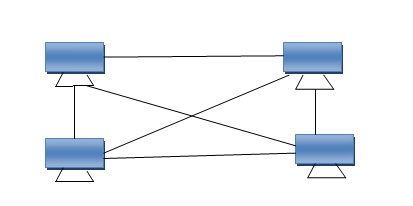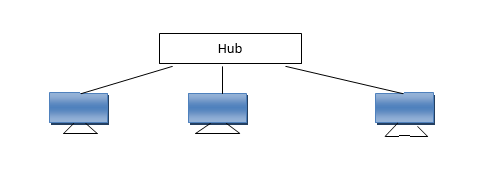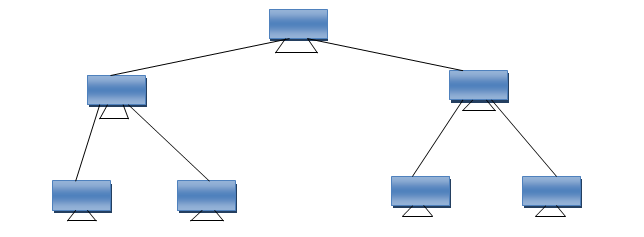In computer fundamentals, network topology is one of the concept which is mostly asked in technical interviews. In this article, you will get a clear understanding of all the popularly used network topologies in the computer network.
Network topology is the physical arrangement of networking devices i.e., how the sender and receiver nodes are connected though cables. There are 5 types of network topologies which are as follows:
- MESH Topology
- RING Topology
- STAR Topology
- BUS Topology
- TREE Topology
Let’s discuss all of them in detail.
Mesh Topology
Mesh topology is a kind of topology in which all the nodes are directly connected with each other. There is a dedicated link between the nodes which makes the data transfer faster.
It uses two techniques to send the data between the nodes which are – flooding and routing. Flooding is a technique of sending data to every other node which is directly connected to sender node and routing is the technique to send the data from the shortest path between the intended nodes.

Advantages of Mesh Topology
- Fast data transfer because the sender node does not have to wait for the connection link to become idle.
- Every connection is able to carry its own data load.
- It provides privacy and security because of point to point connection.
- If one connection link is broken then it will not affect the entire network topology and rest of the nodes will function as usual.
- It is easy to find the faults.
- This topology is very robust.
Disadvantages of Mesh Topology
- Lot of cabling is required which makes it most expensive.
- Mesh topology is complex to install and configure.
- Bulk wiring is essential.
Ring Topology
In ring topology, all the nodes are connected in circular manner through cables. This topology is better than mesh topology in a sense that it does not require bulk wiring and reduces the cost. There is no dedicated link between all the nodes but each node is connected to another node on each side. The last node is connected to the first, thus creates a ring shape. It allows two nodes to have exactly two neighboring nodes.
The data transmission is unidirectional in this topology but you can create a bidirectional topology by connecting each node with another set of connecting lines and it is known as dual ring topology. Here, I have shown two ring networks, with the data flowing in opposite directions.

Advantages of Ring Topology
- It has cheap installation because of less cable use.
Disadvantages of Ring Topology
- If one node crashes, the entire network will be halted because all the nodes are connected in circular manner.
- It is difficult to add or remove nodes, as it interrupts the whole network.
- It is complex to find faultier node in the network.
Star topology
Star topology is the one in which the all the nodes are connected through a hub (central device), which is called the central node. Hub connects all the nodes and when a node needs to communicate to another node then first the data is sent to hub and then hub transfers the data to all the connected nodes. The intended receiving node receives data through hub and never directly communicates to the sender.

Advantages of Star Topology
- It is fast in performance due to low network traffic.
- Installation is easy and can be modified as well.
- Star topology is easy to troubleshoot.
- In case one node is failed, the entire network will not be halted.
Disadvantages of Star Topology
- If the hub fails then, the entire network will stop functioning.
- All the nodes are dependent on hub.
- The installation cost is high.
Bus topology
In bus topology, every node, i.e., every computer in the network is connected to a main cable line like a bus. Data is transferred through the main cable line only. Repeaters are present in the cable line to strengthen the signals when the distance between the sender computer and destination computer increases. The data can only be transmitted in one direction at a time so it is mostly used in small networks.

Advantages of Bus Topology
- It is cost effective as no bulk cabling is required as we compare to mesh topology.
- The main cable is used to connect all the nodes in linear fashion which makes it easy to install and understand.
- You can add as many nodes as possible without any difficulty.
Disadvantages of Bus Topology
- If the main cable fails then, the entire network will collapse.
- The network performance will be affected if you increase the nodes in the network.
- It is slower than ring topology.
- The cable length is limited so you can only add nodes according to wire length.
- As the cable length increases, the cost increases.
Tree topology
Tree topology is the kind of topology in which the connecting nodes are linked with each other in a hierarchical fashion that means, there is a single node called root node and all the other nodes are at lower level connected together like branches of a tree. In this topology, at least 3 levels of hierarchy exist.
Tree topology is applied in WAN (Wide Area Network) because of its expansion property. It is the combination of Bus and Star topology and best for the nodes which are in groups.

Advantages of Tree Topology
- You can add as many nodes as possible, so expansion is simple.
- It is easy to maintain and manage such topology.
- It is easy to detect the faultier node in this network.
Disadvantages of Tree Topology
- It is expansive when you compare it with other topologies.
- If the root node stops functioning then, the entire network will be halted.
- It is profoundly cabled.
The Bottom Line
Network topology is the arrangement of networking devices in a computer network. Mesh, star, ring, bus and tree are popularly used topologies and all of them have their own advantages and disadvantages. When the data needs to be transferred in less time then you should choose mesh topology but when you want to setup a network at low cost then you should choose ring or bus topology. Star topology eliminates the drawbacks of ring topology and a central hub is used for connecting all the nodes. Tree topology is considered to be the best for a larger network as it combines the star and bus topology.











































